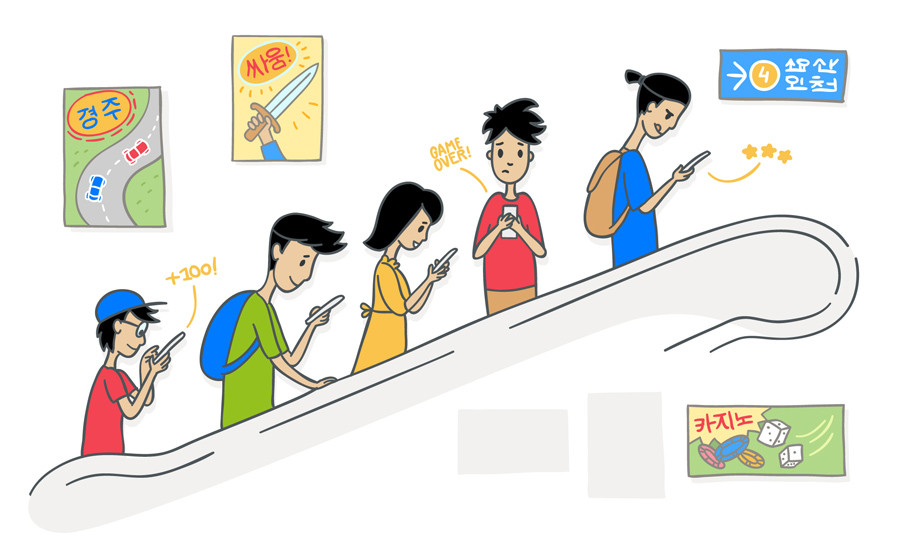
If you want to conquer the Asian gaming market, South Korea should be on your list of countries to focus on. As the world’s fourth-largest game market, South Korea provides game developers with plenty of opportunities. At the same time, Korean players are very demanding in terms of proper translation and localization, so if you don’t approach it right you could wind up in trouble.
In this article we’ll briefly review the Korean game market and see what kind of players prefer what kind of games. And of course, we’ll talk about some localization tips specific to Korea: by knowing them, you will significantly minimize the possible risks and increase the chances of your game becoming the next big hit.
South Korea: audience overview
In 2018, about 56% of the total South Korean population of 51 million people were gamers. Of these, 73% were male, though the number of female gamers is growing rapidly. And these numbers are on the rise!
As for the average age of Korean gamers, these are usually young people either 14–19 years old or 20–29 years old. However, people ages 30 to 50 play a lot of games as well, so don’t overlook this category of users.
Game revenues and spending
Surprisingly, Korean gamers are among the biggest game spenders in the world. In 2018, 85% of players spent money on in-app purchases, and the average Korean player spends about $200 per year.
As for revenues generated, in 2019 game revenues reached approximately $6.2B in South Korea. Considering that revenues in Germany, France, or the UK were less than $4B, the Korean numbers are pretty impressive.
It is also worth noting that Korean gamers mostly prefer free games, so the best option would be the freemium model. Under this model, while the game itself is free, it offers in-app purchases, and players can decide whether or not to buy them.
Game preferences
South Korea was an early investor in 5G mobile service and has a large number of Internet cafes across the country, and this has had a certain impact on the game preferences of Korean players. The key takeaways are:
- Korean players enjoy competitive games
- Korean players like to be part of a team when gaming
- Koreans often view games as a social element.
As for genres, in Korea RPGs are number one (57.9%), followed by strategy (12.2%) and action (8.4%). Female players also favor puzzles and casual games, but RPGs remain at the top. In fact, in H1 of 2020, none of the top mobile games in South Korea were casual, while RPG, strategy, action, simulation, and sports were in the top 5 spots.
Fun fact: in 2020, the top-grossing games in South Korea were:
- Lineage 2M
- Lineage M
- Rise of Kingdoms: Lost Crusade
Mobile vs PC
Even though Koreans play PC games a lot, mobile games dominate the Korean market. The average Korean user has 52 apps installed on their phone, which is quite impressive. South Korea is also among the top 4 countries that spend the most time (about 4 hours daily) on mobile apps, alongside Indonesia, China, and Brazil.
Hence, mobile app developers have a good chance of success if they decide to tap into the Korean market. Note that Koreans also have special preferences in terms of devices: the Galaxy series seems to be the most popular, and most smartphones used by Koreans are over 5.5 inches (in 2019, more than 50% of devices sold had screens of 6 inches or larger).
Localizing your game for South Korea: things to keep in mind
As we mentioned above, there are certain things about localization for Korea that must be kept in mind. Otherwise, you have a high chance of annoying the players and harming your revenue, even though the game itself may be stellar.
Double-check your localized content
There was an infamous case with the game Darkest Dungeons, which in 2018 angered Korean players with poorly localized text. There was a signature phrase in the game, “Claim your birthright,” which for some reason was translated as “Find your life.” And this wasn’t the only line in the game that wasn’t localized correctly.
Of course, the mistakes did not go unnoticed. Korean players were deeply upset, and their reaction led the company to apologize publicly.
This is not the only instance of Korean players speaking out if they do not like something about a game. Hence, it is vital not only to find professional translators but also to perform localization testing once the content is translated. This will ensure that there are no mistakes and that the original meaning of the game is retained.
Join forces with Kakao
Another thing that we have already discussed is that games for Korean players are more than just entertainment: they are a way to socialize. This means you need to incorporate this social element into your game. Examples would be: make it multiplayer, add an option to send in-game gifts or messages to friends, add friends from your contact list, etc.
An excellent example of adding a social element to a game is the incorporation of Kakao into the Candy Crush Saga game. Kakao is the most popular messaging system in Korea and is the second-largest channel for mobile game distribution (Google Play, obviously, is number one). So King, the developer of Candy Crush Saga, integrated the Kakao messenger into the game, giving players access to exclusive emojis and allowing them to send requests to their friends. Needless to say, it was a big hit.
Bear in mind, however, that Kakao is very demanding in terms of publishing a new mobile app or game. They demand excellent Korean, and the app must meet the messenger’s high standards. Thus, if you decide to collaborate with Kakao, your localization should be on point even in the tiniest details.
Localize images
While image localization might seem like an obvious step, many developers may overlook it. And considering how demanding Korean players are, it is definitely worthy of considerable attention.
One example was altering the shoes for Ryuji, a character in the game Persona 5. While the original design featured the Rising Sun flag on his shoes, developers decided to remove the symbol from the shoes for the Korean audience.
On the one hand, it can be argued that Ryuji belongs to the yankii subculture, which still exists in Japan. And when a yankii decides to join the bosozoku, a motorcycle subculture, they often start wearing the Rising Sun flag on their clothes, helmets, etc.
On the other hand, Korean players have no connection to Japanese subcultures and they do not have to understand their intricacies. Hence, to prevent confusion or controversy, game devs simply removed the image from the sneakers — and this is a really good example of understanding the culture for which you are localizing.
A small case study from Alconost: Mad GunZ and Blocky Cars
Mad GunZ and Blocky Cars are games by Full HP — a major international game dev company. The company wanted to make the games global, so it decided to make them accessible in 12 languages, with the Russian audience getting early access. As for the other countries, Full HP needed help from a reliable localization agency, so they approached Alconost.
Korea was among the countries that Full HP targeted, and we had to be really careful about game localization for the Korean audience. One of the major changes made with game advertisements was replacing horizontal screenshots with vertical ones and making the screenshots more colorful and vivid (elements that appeal to Asian audiences). We did not alter the in-game characters and visuals, as the Korean audience is more tolerant than, say, the Chinese. Still, we had to be very careful about how we localized the game for the Korean market, and to make sure it looked native and appealing.
Word order and writing
One of the most important parts of localization is to consider the writing rules and letter size of a given language and to adjust the UI correspondingly. For example, Chinese characters are larger than English letters, so obviously you need to allow them sufficient space if you want to localize your game for the Chinese audience.
With the Korean language, there are several aspects to keep in mind. One Korean character typically takes up as much space as two English characters, so you’d want to consider that when working on the UI. Also, Korean can be written both horizontally (from left to right) and vertically. Vertical writing is considered outdated, so you can use it for old manuscripts found in the game, but not for general game/app content.
Another important point is that Korean word order differs drastically from English. For example, when mentioning numbers in a sentence, the larger number goes first. So if in the game you have the phrase, “Select 2 out of 5 potions,” in Korean it would be “Out of 5 potions, select 2.”
And of course, remember that in Korean one word may have several meanings. For example, the word “chest” may be written in three dfferent forms according to the meanings “human chest,” “box,” or “treasure chest.” NeverEnding Games made this mistake when translating “Special Chest” (meaning “special treasure chest”) as “Special Human Chest” in Korean. Of course, they quickly fixed the mistake, but it’s an excellent example of how important professional translation is.
Localization of pricing
We’ve already mentioned that Korean players are huge spenders — but in order to make them spend money, you need to localize the pricing correctly.
Rule number one is: do not use foreign currencies such as the dollar or the euro! Korean players want to see the Korean won in the game or app they’re using. You can use either ₩ or 원; both options are acceptable. Using the acronym KRW is not recommended, as it is not common in Korea.
It is also critical to make the pricing clear and understandable. That means using commas correctly, not using decimal points, and using only whole numbers. For example: use ₩ 1,200 instead of ₩ 1120.00.
Summing up
The Korean market is very demanding and it may take quite a lot of time and resources to localize your product in adherence to its standards. But think about that for a second.
Koreans are willing to spend money on your game, and the Korean game market shows steady growth. By localizing your product for Korean players, you will expose it to a vast audience that is enthusiastic about your game and is willing to make in-app purchases. Not only will you double your fanbase, you will also be able to get a satisfactory return on investment, and maybe even become one of the top games in Korea.
Obviously, considering the level of quality that Korean players expect, you cannot rely on community-based translation alone. Your best option is to combine crowdsourcing and professional localization. This ensures that everything is done on time, and also that none of the important aspects of the Korean language and communication style is missed.
About the Author
The article was written by Alconost. We localize games in more than 70 languages and create game videos in any genre and in any language.





What games are popular right now? And what do people prefer to play? I'm not interested in finding a game for myself. I want to develop in the gaming industry. I think that this is now relevant and in demand.